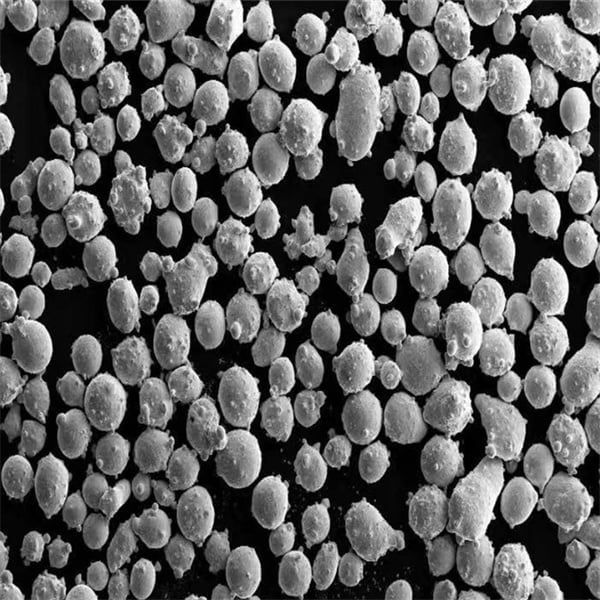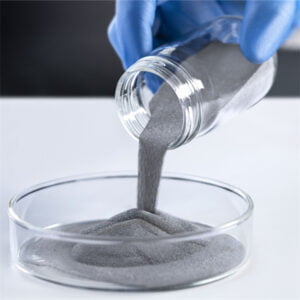Atomización con gas inerte al vacío
Índice
Visión general
En el mundo de la fabricación avanzada, la búsqueda de la perfección en los materiales ha llevado al desarrollo de numerosas técnicas sofisticadas. Uno de estos métodos revolucionarios es Atomización con gas inerte al vacío (VIGA). Este proceso desempeña un papel fundamental en la producción de polvos metálicos de alta calidad, esenciales para diversas aplicaciones como la fabricación aditiva, la pulvimetalurgia y los recubrimientos especializados. En este artículo, profundizamos en las complejidades de VIGA, explorando sus procesos, beneficios, limitaciones y aplicaciones.
Descripción general de la atomización de gas inerte al vacío
La atomización con gas inerte al vacío (VIGA) es un método de vanguardia para producir polvos metálicos finos y esféricos. Este proceso consiste en fundir un metal al vacío y, posteriormente, introducir un gas inerte para atomizar el metal fundido en diminutas gotas que se solidifican en polvos finos. VIGA es reconocido por su capacidad para producir polvos de alta pureza con tamaños de partícula controlados, lo que lo hace indispensable en las industrias de alta precisión.

Cómo Atomización con gas inerte al vacío Obras
VIGA opera en un entorno controlado para garantizar la producción de polvos metálicos de calidad superior. A continuación, se detalla el proceso paso a paso:
- Fundición:El metal o aleación se funde en un horno de inducción al vacío.
- Atomización:El metal fundido se vierte a través de una boquilla en una cámara donde se atomiza mediante una corriente de gas inerte a alta presión (como argón o nitrógeno).
- SolidificaciónLas diminutas gotas de metal se enfrían rápidamente y se solidifican formando polvos finos y esféricos.
- Colección:Los polvos se recogen en una cámara, se separan del gas inerte y se tamizan para lograr la distribución de tamaño de partícula deseada.
Modelos clave de polvo metálico producidos por VIGA
El proceso VIGA permite producir una amplia gama de polvos metálicos, cada uno con propiedades únicas adaptadas a aplicaciones específicas. A continuación, se presentan algunos modelos destacados:
| Modelo de polvo metálico | Composición | Propiedades | Aplicaciones |
|---|---|---|---|
| Acero inoxidable 316L | Fe-16,5Cr-10Ni-2Mo | Alta resistencia a la corrosión, buena soldabilidad | Implantes médicos, componentes aeroespaciales |
| Ti-6Al-4V | Ti-6Al-4V | Alta relación resistencia-peso, biocompatible | Piezas aeroespaciales, dispositivos biomédicos |
| AlSi10Mg | Al-10Si-0,4Mg | Ligero, buena conductividad térmica | Piezas de automóviles, intercambiadores de calor |
| Inconel 718 | Ni-52Cr-19Fe-5Nb-3Mo-1Ti | Resistencia a altas temperaturas, resistencia a la corrosión | Álabes de turbinas, reactores nucleares |
| Cobre | Cu puro | Excelente conductividad eléctrica y térmica. | Componentes eléctricos, disipadores de calor |
| Acero martensítico envejecido (18Ni300) | Fe-18Ni-9Co-5Mo-1.5Ti | Alta resistencia, buena tenacidad | Herramientas, piezas de alto rendimiento |
| Cromo-cobalto (CoCrMo) | Co-28Cr-6Mo | Alta resistencia al desgaste, biocompatible | Implantes dentales, dispositivos ortopédicos |
| Superaleaciones a base de níquel (Hastelloy X) | Ni-22Cr-18Fe-9Mo | Excepcional resistencia a la oxidación y la corrosión | Aeroespacial, procesamiento químico |
| Aleación de aluminio 7075 | Al-5,6Zn-2,5Mg-1,6Cu | Alta resistencia, buena resistencia a la fatiga | Marcos aeroespaciales, artículos deportivos |
| Estelita 21 | Co-28Cr-4Mo | Resistencia al desgaste, estabilidad a altas temperaturas. | Herramientas de corte, componentes de motor |
Aplicaciones de la atomización de gas inerte al vacío
La versatilidad de los polvos producidos por VIGA abre numerosas posibilidades de aplicación en diversas industrias. A continuación, se presentan algunos de los usos más importantes:
| Industria | Aplicaciones |
|---|---|
| Aeroespacial | Álabes de turbina, componentes estructurales, elementos de fijación |
| Médico | Implantes ortopédicos, prótesis dentales |
| Automoción | Piezas de motor, componentes estructurales ligeros |
| Electrónica | Tintas conductoras, materiales de soldadura |
| Energía | Reactores nucleares, pilas de combustible |
| Herramientas | Herramientas de corte, moldes, troqueles. |
| Fabricación aditiva | Impresión 3D, creación de prototipos |
| Revestimientos | Recubrimientos de barrera térmica, recubrimientos resistentes al desgaste |
Ventajas de Atomización con gas inerte al vacío
VIGA ofrece varias ventajas que lo convierten en la opción preferida para la producción de polvo metálico:
- Alta pureza:El entorno de vacío minimiza la contaminación, garantizando polvos de alta pureza.
- Tamaño de partículas controlado:El control preciso de los parámetros de atomización da como resultado tamaños de partículas uniformes.
- Partículas esféricas:El proceso produce polvos esféricos, mejorando la fluidez y la densidad de empaque.
- Versatilidad: Capaz de procesar una amplia gama de metales y aleaciones.
- Oxidación reducida:El ambiente de gas inerte reduce la oxidación, preservando las propiedades del polvo.
Desventajas de la atomización con gas inerte al vacío
A pesar de sus muchos beneficios, VIGA tiene algunas limitaciones:
- Coste elevado:Los costos de equipo y operación son relativamente altos en comparación con otros métodos de atomización.
- Complejidad:El proceso requiere sistemas de control sofisticados y operadores capacitados.
- Escala de producción limitada:Por lo general, VIGA es más adecuado para producciones de pequeña a mediana escala.
Comparación de VIGA con otros métodos de atomización
Al elegir un método de atomización, es fundamental comparar VIGA con otras técnicas como la atomización por agua y la atomización por gas. A continuación, se muestran sus ventajas:
| Método | Forma de las partículas | Pureza | Coste | Escala de producción | Aplicaciones |
|---|---|---|---|---|---|
| VIGA | Esférica | Alta | Alta | Medio | Industrias de alta precisión, aeroespacial |
| Atomización del agua | Irregular | Moderado | Bajo | Alta | Metalurgia de polvos, polvos de acero |
| Atomización de gases | Esférica | Alta | Moderado | Medio | Fabricación aditiva, aleaciones especiales |

Especificaciones, tamaños y normas
Para garantizar la consistencia y la calidad, los polvos metálicos producidos a través de VIGA cumplen con estándares y especificaciones específicos:
| Polvo metálico | Gama de tamaños de partículas (µm) | Normas |
|---|---|---|
| Acero inoxidable 316L | 15-45, 45-150 | ASTM A276, ISO 5832-1 |
| Ti-6Al-4V | 15-53, 53-150 | ASTM F2924, ISO 5832-3 |
| AlSi10Mg | 20-63, 63-125 | ASTM B928, ISO 209-1 |
| Inconel 718 | 15-45, 45-150 | ASTM B637, ISO 6208 |
| Cobre | 10-75, 75-150 | ASTM B216, ISO 3497 |
| Acero martensítico envejecido (18Ni300) | 15-45, 45-150 | ASTM A646, ISO 4955 |
| Cromo-cobalto (CoCrMo) | 20-53, 53-150 | ASTM F1537, ISO 5832-4 |
| Superaleaciones a base de níquel (Hastelloy X) | 15-53, 53-150 | ASTM B435, ISO 6208 |
| Aleación de aluminio 7075 | 20-63, 63-125 | ASTM B209, ISO 6362-2 |
| Estelita 21 | 20-63, 63-150 | ASTM F75, ISO 5832-4 |
Proveedores y precios
Encontrar proveedores confiables y comprender los detalles de precios es esencial para las compras. A continuación, se presenta un resumen de algunos proveedores destacados y sus precios:
| Proveedor | Polvos metálicos ofrecidos | Gama de precios (por kg) | Ubicación |
|---|---|---|---|
| Sandvik Osprey | Acero inoxidable, titanio | $150 – $300 | Suecia |
| Tecnología Carpenter | Aleaciones de níquel, aleaciones de cobalto | $200 – $500 | EE.UU. |
| Höganäs AB | Polvos de acero, aluminio | $50 – $200 | Suecia |
| Tecnología LPW | Varias aleaciones, polvos personalizados | $100 – $400 | REINO UNIDO |
| AP&C (Aditivo GE) | Titanio, aluminio | $200 – $600 | Canadá |
Comparación de pros y contras
Comprender las ventajas y limitaciones de VIGA es crucial para tomar decisiones informadas:
| Pros | Contras |
|---|---|
| Alta pureza y composición controlada. | Alto costo de equipo y operación |
| Partículas esféricas con buena fluidez. | Requiere operarios cualificados |
| Versatilidad en tipos de metales y aleaciones. | Limitado a producción de pequeña a mediana escala |
| Oxidación reducida debido al gas inerte | Proceso complejo con un control estricto |

PREGUNTAS FRECUENTES
| Pregunta | Respuesta |
|---|---|
| ¿Para qué se utiliza VIGA? | VIGA se utiliza para producir polvos metálicos de alta calidad para aplicaciones en la industria aeroespacial, médica y de fabricación aditiva. |
| ¿En qué se diferencia VIGA de la atomización de gas? | VIGA utiliza vacío y gas inerte para minimizar la contaminación y la oxidación, dando como resultado polvos de mayor pureza. |
| ¿Qué metales se pueden procesar utilizando VIGA? | Una amplia gama de metales y aleaciones, incluidos acero inoxidable, titanio, aluminio y superaleaciones a base de níquel. |
| ¿Cuáles son los rangos de tamaño de partículas que se pueden lograr con VIGA? | Normalmente, VIGA puede producir polvos con tamaños de partículas que van desde 10 µm a 150 µm. |
| ¿Es VIGA rentable? | Si bien VIGA ofrece alta calidad y precisión, generalmente es más costoso que otros métodos de atomización. |
En conclusión, la atomización con gas inerte al vacío se destaca como una técnica de vanguardia para la producción de polvos metálicos de alta calidad, esencial para diversas aplicaciones de alta precisión. Su capacidad para producir polvos esféricos de alta pureza con tamaños de partícula controlados la hace indispensable en campos que abarcan desde la industria aeroespacial hasta los implantes médicos. Si bien conlleva mayores costos y complejidad, las ventajas a menudo superan las desventajas en aplicaciones que exigen un rendimiento de materiales de primera calidad. A medida que las industrias continúan innovando, el papel de técnicas avanzadas como VIGA en la configuración del futuro de la fabricación es fundamental.
Compartir
MET3DP Technology Co., LTD es un proveedor líder de soluciones de fabricación aditiva con sede en Qingdao, China. Nuestra empresa está especializada en equipos de impresión 3D y polvos metálicos de alto rendimiento para aplicaciones industriales.
Solicite información para obtener el mejor precio y una solución personalizada para su empresa.
Artículos relacionados

Segmentos de álabe de tobera de alto rendimiento: Revolucionando la eficiencia de las turbinas con la impresión metálica en 3D
Leer Más "Acerca de Met3DP
Actualización reciente
Nuestro producto
CONTACTO
¿Tiene alguna pregunta? ¡Envíenos un mensaje ahora! Atenderemos su solicitud con todo un equipo tras recibir su mensaje.

Polvos metálicos para impresión 3D y fabricación aditiva
PRODUCTO
cONTACT INFO
- Ciudad de Qingdao, Shandong, China
- [email protected]
- [email protected]
- +86 19116340731
















